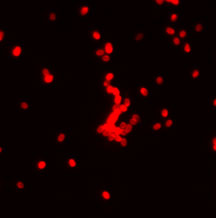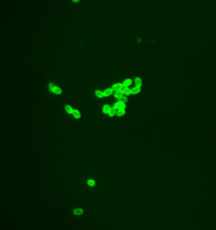TSRI Research Suggests Powerful Tool for Detection and Treatment
of Anthrax
By Jason Socrates
Bardi
Human antibodies against Bacillus spores, of which
one species is the cause of anthrax, have been identified
by researchers at The Scripps Research Institute (TSRI). These
antibodies could be used to detect the presence of anthrax
and other harmful spores in powders and to protect those exposed
against lethal infections.
In the current issue of the journal Proceedings of the
National Academy of Sciences, scientists Bin Zhou, Peter
Wirsching, and Kim D. Janda of the Department of Chemistry
and The Skaggs Institute for Chemical Biology describe the
antibodies.
"The antibodies," says Janda, who holds the Ely R. Callaway,
Jr. Chair in Chemistry, "give you the ability to dissect very
quickly what you have—whether it's a hazardous spore
preparation or just plain baby powder."
Using donated blood, the researchers were able to find a
number of human antibodies that were all highly specific for
spores of Bacillus subtilis, a close cousin of Bacillus
anthracis which is the causative agent of anthrax, and
11 other types of bacterial spores. Work on Bacillus anthracis
itself is currently getting underway.
The researchers found the antibodies using phage display,
a method for selecting from billions of antibody variants
only those that bind to a particular target. In the technique,
the antibody repertoire obtained from white blood cells is
fused to a viral coat protein of the phage—a filamentous
virus that infects bacteria—to create an antibody "library."
Since the phage virus displays the antibodies on the surface
of the virion, it makes them easy to select for in vitro
Bacillus spores. Those that cannot bind are washed away,
while those that bind to the spores are selected.
By attaching a fluorescent chemical to the antibodies, Janda
and his colleagues could look under a specially equipped microscope
and quickly determine whether a powdered sample had any spores
present. They could even detect a single spore.
"We've shown for the first time that human antibodies can
recognize spore surfaces," says Janda, who adds that the antibodies
might make a powerful and convenient tool for detecting anthrax.
Moreover, antibodies that bind to spores have important
implications for treating individuals who are exposed to anthrax.
Since the antibodies come from humans, they could be given
to individuals to passively immunize them—the antibodies
would help to clear anthrax spores from the individual's system.
And, because of the ease of producing and administering antibodies,
they represent a simple, inexpensive, and potentially powerful
therapy.
The research article "Human antibodies against spores of
the genus Bacillus: a model study for detection of
and protection against anthrax and the bioterrorist threat"
is authored by Bin Zhou, Peter Wirsching, and Kim D. Janda
and appears in the April 16, 2002 issue of Proceedings
of the National Academy of Sciences.
The research was funded in part by The Skaggs Institute
for Chemical Biology.
Link:
San
Diego Union-Tribune coverage

|


By attaching a fluorescent chemical
to the antibodies, investigator Kim Janda and his colleagues
could look under a specially equipped microscope and quickly
determine whether a powdered sample had any spores present.
Here, the Bacillus subtilis spores are shown bound to FITC-labeled
phage (top) and rhodamine-labeled phage (bottom).
|

